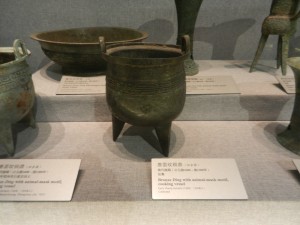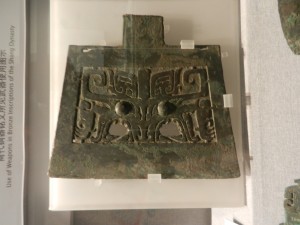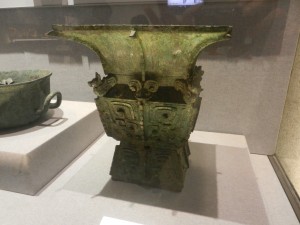Here’s a shot of a reconstructed portion of the Shang Dynasty city walls of Zhengzhou. This is what the area around a gate might have looked like.
11 openings have been found in Zhengzhou’s Shang Dynasty walls. People lugged goods from these gates to many surrounding states. Zhengzhou’s artisans were developing key trends in perspective, and their works spread through much of what became modern China. So we’ll explore some of Chinese culture’s ancient roots.
Some facts about the early Shang Dynasty’s bronze ritual vessels, which royals used to commune with their ancestors and help keep the state in order are:
1. Their designs evolved. At first they were in a thin band around the vessel.
2. Then the lines’ thickness began to vary and become more expressive.
One of the most common patterns on Shang bronzes is the taotie. This is a fierce looking animal’s face seen from the front, but without the lower jaw. The eyes are emphasized. The ceremonial ax blade from the late Shang Dynasty in the above shot sports one. Specialists haven’t agreed about what the taotie represented, or if it was even supposed to represent anything. But it was symmetrical and animated.
The new variation of line thickness allowed the taotie patterns to become vivid. Artists started to combine dragon motifs with the taotie.
Marxist historians have seen the Shang Dynasty as a classic ancient society that used slaves for production. The Shang elites supposedly used shock and awe tactics to intimidate laborers into being docile. Thus the early Shang bronzes became increasingly animated, like the late Shang vessel in the above shot.
But things in the Shang Dynasty weren’t so simple. In the next post on Shang China, we’ll see that some of its developments became key roots of some of Chinese culture’s finest art and thought.





Comments on this entry are closed.